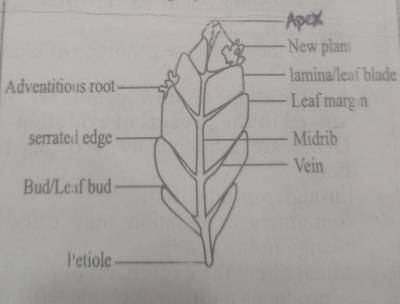Study specimens F, H and K and answer questions 2(a) to 2(d).
(a) State four functions of specimen H to the plant from which it was obtained.
b(i) State one function each of specimen F and K to the plants from which they were obtained.
F:
K:
(ii) Give one reason for the answers in 2b(i)
F:
K:
(iii) What part of the plant is modified for the function stated in 2b(i)?
F:
K:
c(i) State four observable differences between specimens F and K.
| F | K |
(ii) State one similarity between specimens F and K.
(d) Make a drawing; 6 cm to 8 cm long of the specimen H and label fully.

Specimen F - Ginger rhizome
Specimen H - Leaf of Boplytum
Specimen K - Cassava tuber
(a) Functions of specimen H to the plant from which it was obtained.
- site for photosynthesis
- for exchange of gases
- for transpiration
- asexual reproduction
- water storage
b(i) one function each of specimen F and K to the plants from which they were obtained.
F: stores food, helps the plant reproduce and survive unfavorable seasons.
K: storage of food
(ii) one reason each for the answers in 2b(i)
F: presence of buds / rhizome located underground
K: presence of swollen root
(iii) Part of the plant modified for the function stated in 2b(i)?
F: stem
K: root
c(i)Four observable differences between specimens F and K.
| F(Ginger rhizome) | K(Cassava) |
| presence of buds | absence of buds |
| presence of nodes and internodes | Absence of nodes and internodes |
| presence of adventitious roots | presence of lateral roots |
| smaller in size | Bigger in size |
(ii) Similarity between specimens F and K.
- both are modified underground stems.
- both storage organs.
- both swollen
- both are carbohydrates
(d) Labelled diagram of Specimen H (see diagram above)
Contributions ({{ comment_count }})
Please wait...
Modal title
Report
Block User
{{ feedback_modal_data.title }}